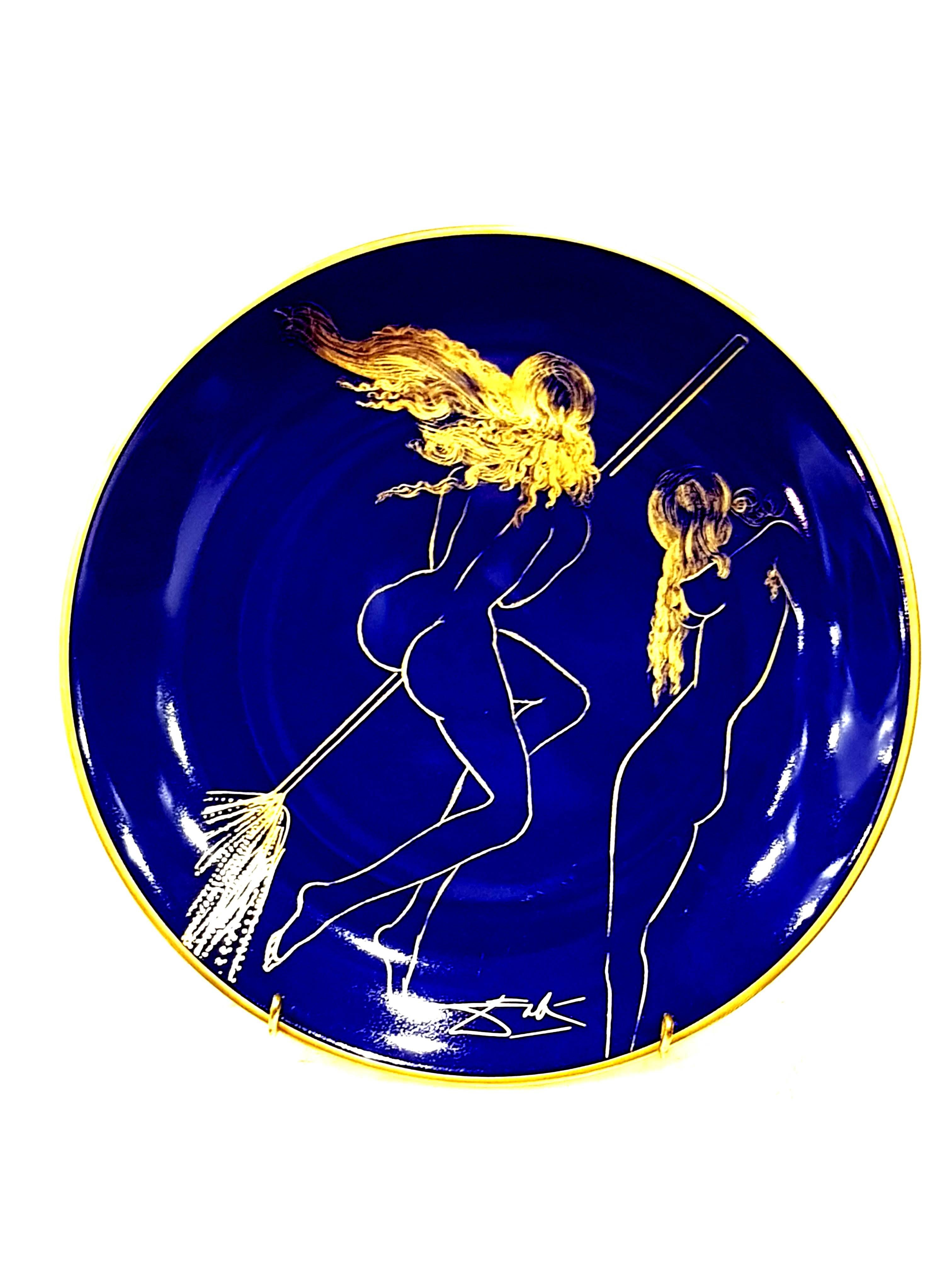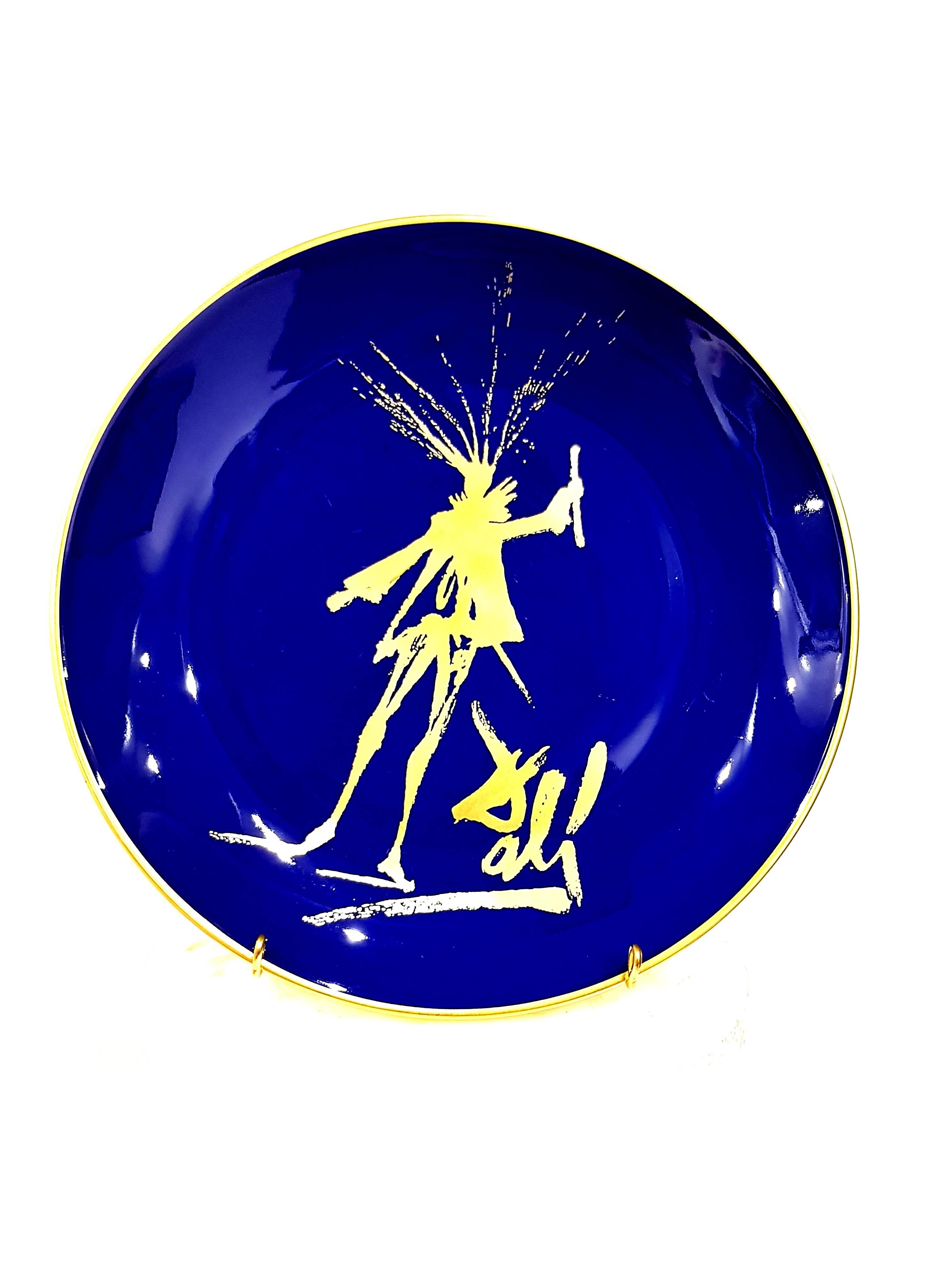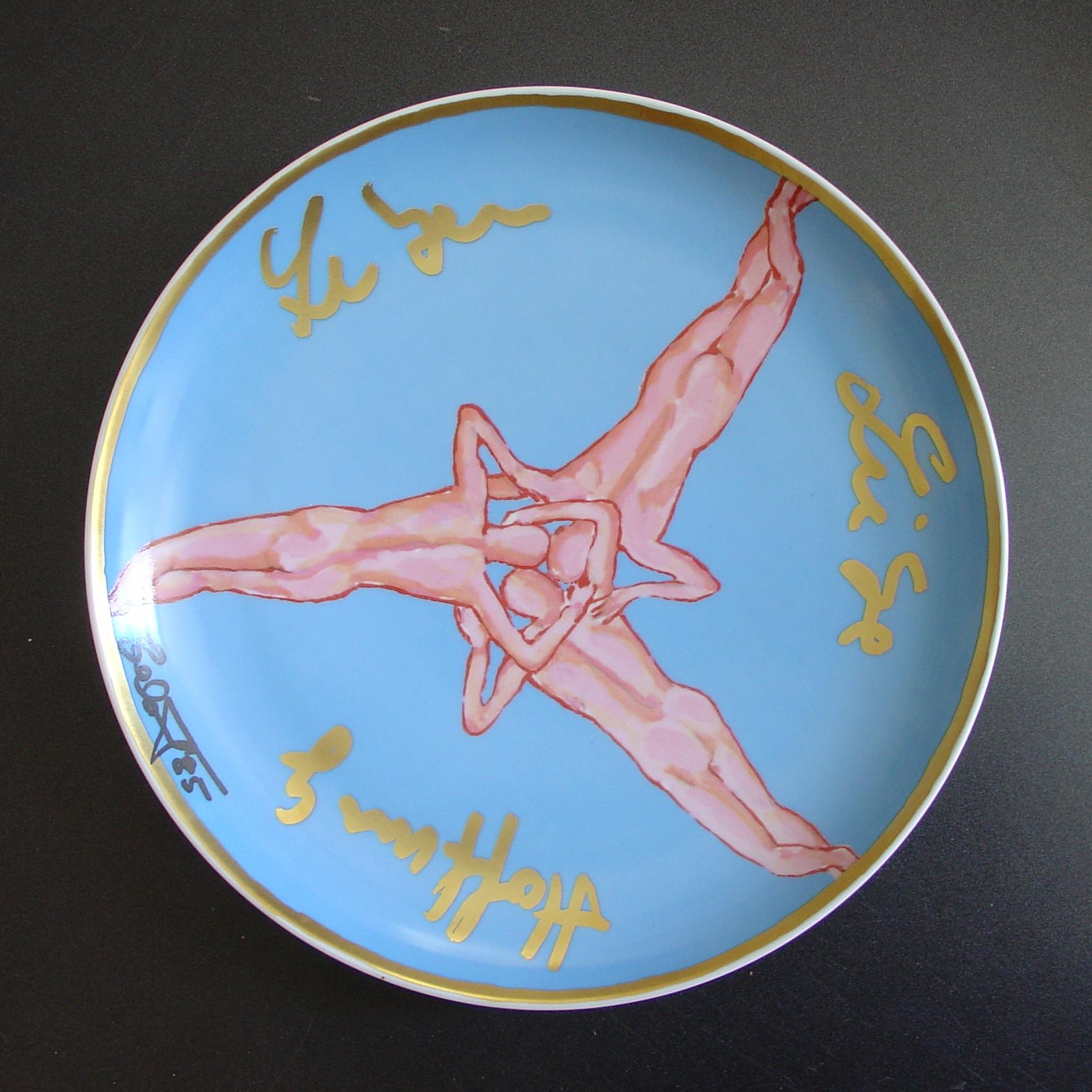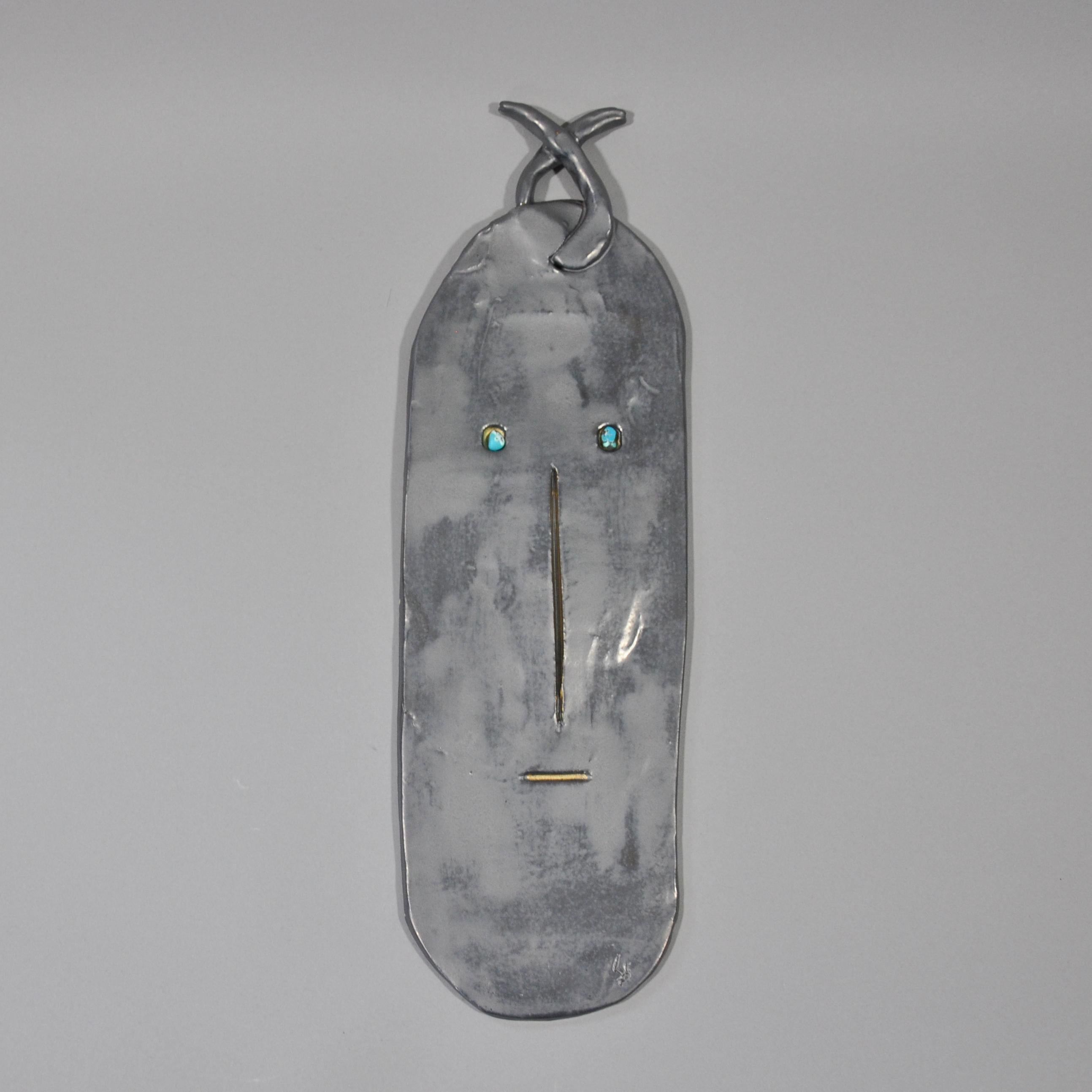Items Similar to Venus - Limoges Porcelain Blue and Gold
Want more images or videos?
Request additional images or videos from the seller
1 of 10
(after) Salvador DaliVenus - Limoges Porcelain Blue and Gold1967
1967
About the Item
Limoges porcelain in "Bleu de Sèvres" and gold.
Artist: Salvador Dali
Exclusive limited edition to 2000 copies "Raynaud & Co. Limoges", France, 1968.
"Silhouette de Faust" drawn by Salvador Dalí. Print signed.
Plate Signed in the back of the plate
Dimensions: Diameter: 26 cm
Edited by Salins Earthenware
Sold in its original box
The company "Raynaud-Limoges" specialized in the production of porcelain products in small runs, among the company's customers - crowned people and representatives of the old aristocratic families of Europe.
Dali - the Prodigy Child without an Exam.
Salvador Dali was born as the son of a prestigious notary in the small town of Figueras in Northern Spain. His talent as an artist showed at an early age and Salvador Felipe Jacinto Dali received his first drawing lessons when he was ten years old. His art teachers were a then well known Spanish impressionist painter, Ramon Pichot and later an art professor at the Municipal Drawing School. In 1923 his father bought his son his first printing press.
Dali began to study art at the Royal Academy of Art in Madrid. He was expelled twice and never took the final examinations. His opinion was that he was more qualified than those who should have examined him.
In 1928 Dali went to Paris where he met the Spanish painters Pablo Picasso and Joan Miro. He established himself as the principal figure of a group of surrealist artists grouped around Andre Breton, who was something like the theoretical "schoolmaster" of surrealism. Years later Breton turned away from Dali accusing him of support of fascism, excessive self-presentation and financial greediness.
By 1929 Dali had found his personal style that should make him famous the world of the unconscious that is recalled during our dreams. The surrealist theory is based on the theories of the psychologist Dr. Sigmund Freud. Recurring images of burning giraffes and melting watches became the artist's surrealist trademarks. His great craftsmanship allowed him to execute his paintings in a nearly photo-realistic style. No wonder that the artist was a great admirer of the Italian Renaissance painter Raphael.
Salvador Dali and Gala.
Meeting Gala was the most important event in the artist's life and decisive for his future career. She was a Russian immigrant and ten years older than Dali. When he met her, she was married to Paul Eluard.
Gala decided to stay with Dali. She became his companion, his muse, his sexual partner, his model in numerous art works and his business manager. For him she was everything. Most of all Gala was a stabilizing factor in his life. And she managed his success in the 1930s with exhibitions in Europe and the United States.
Gala was legally divorced from her husband in 1932. In 1934 Dali and Gala were married in a civil ceremony in Paris and in 1958 in church after Gala's former husband had died in 1952. However from around 1965 on, the couple was seen less frequently together. But Gala continued to manage Dali's business affairs.
1933 Salvador Dali had his first one-man show in New York. One year later he visited the U.S. for the first time supported by a loan of US$500 from Pablo Picasso. To evade World War II, Dali chose the U.S.A. as his permanent residence in 1940. He had a series of spectacular exhibitions, among others a great retrospective at the Museum of Modern Art in New York.
Besides creating a number of great paintings, Dali caused the attention of the media by playing the role of a surrealist clown. He made a lot of money and was contemptuously nicknamed Avida Dollars (greedy for dollars) by Andre Breton.
Dali became the darling of the American High Society. Celebrities like Jack Warner or Helena Rubinstein gave him commissions for portraits. His art works became a popular trademark and besides painting he pursued other activities - jewelry and clothing designs for Coco Chanel or film making with Alfred Hitchcock.
The Classic Period After World War II
In 1948 Dali and Gala returned to Europe, spending most of their time either in their residence in Lligat or Spain or in Paris or France or in New York. Dali developed a lively interest in science, religion and history. He integrated things into his art that he had picked up from popular science magazines.
Another source of inspiration were the great classical masters of painting like Raphael, Velasquez or the French painter Ingres. The artist commented his shift in style with the words: "To be a surrealist forever is like spending your life painting nothing but eyes and noses."
In 1958 the artist began his series of large sized history paintings. He painted one monumental painting every year during the summer months in Lligat. The most famous one, The Discovery of America by Christopher Columbus, can be seen at the Dali Museum in St. Petersburg in Florida. It is breath-taking. The artist's late art works combine more than ever his perfect and meticulous painting technique with his fantastic and limitless imaginations.
Salvador Dali is the only known artist who had two museums dedicated exclusively to his works at lifetime.
Dali Museum in St. Petersburg, Florida
The Dali Museum in St. Petersburg in Florida or U.S.A. was founded in 1971 by the Dali collector A. Reynolds Morse and his wife Eleanor. The collection was first exhibited in a building adjacent to their home in Cleveland/Ohio.
In 1982, the museum was moved to St. Petersburg in Florida. It hosts 95 oil paintings including six of Dali's eighteen large-sized historical paintings.
Dali Museum-Theater in Figueres, Spain.
The Dali Museum-Theater in Figueres, Spain was the former Municipal Theater of Figueres. In 1918, when Salvador Dali was only fourteen years old, it had shown his first public exhibition.
Since 1970 the artist had dedicated his energy to transform the former Municipal Theater into a museum and art gallery. In 1974 the Theatro Museo Dali was officially opened.
1980 Dali was forced to retire due to palsy, a motor disorder, that caused a permanent trembling and weakness of his hands. He was not able to hold a brush any more. The fact that he could not follow his vocation and passion of painting and the news of Gala's death in 1982 left him with deep depressions.
After Gala's death he moved to Pubol, a castle, he had bought and decorated for Gala. In 1984, when he was lying in bed, a fire broke out and he suffered sever burns. Two years later, a pacemaker had to be implanted.
Towards the end of his life, Dali lived in the tower of his own museum where he died on January 23, 1989 from heart failure.
- Creator:(after) Salvador Dali (1904 - 1989, Spanish)
- Creation Year:1967
- Dimensions:Height: 0.79 in (2 cm)Width: 10.24 in (26 cm)Depth: 10.24 in (26 cm)
- Medium:
- Movement & Style:
- Period:
- Condition:
- Gallery Location:Collonge Bellerive, Geneve, CH
- Reference Number:1stDibs: LU16122565451
About the Seller
4.9
Platinum Seller
These expertly vetted sellers are 1stDibs' most experienced sellers and are rated highest by our customers.
Established in 2015
1stDibs seller since 2015
907 sales on 1stDibs
Typical response time: 1 hour
- ShippingRetrieving quote...Ships From: Collonge Bellerive, Geneve, Switzerland
- Return PolicyA return for this item may be initiated within 7 days of delivery.
More From This SellerView All
- Sabat - Limoges Porcelain Blue and GoldBy (after) Salvador DaliLocated in Collonge Bellerive, Geneve, CHLimoges porcelain in "Bleu de Sèvres" and gold. Artist: Salvador Dali Exclusive limited edition to 2000 copies "Raynaud & Co. Limoges", France, 1968. "Sabat" drawn by Salvador Dalí...Category
1960s Modern Mixed Media
MaterialsPorcelain
- Faust - Limoges Porcelain Blue and GoldBy (after) Salvador DaliLocated in Collonge Bellerive, Geneve, CHLimoges porcelain in "Bleu de Sèvres" and gold. Artist: Salvador Dali Exclusive limited edition to 2000 copies "Raynaud & Co. Limoges", France, 1968. "Faust" drawn by Salvador Dalí...Category
1960s Modern Mixed Media
MaterialsPorcelain
- Jean Picart Le Doux - Sunshine - Original Salins EarthenwareBy Jean Picart Le DouxLocated in Collonge Bellerive, Geneve, CHOriginal Salins Earthenware Plate Artist: Jean Picart Le Doux Title: Sunshine Signed in the back of the plate Dimensions: Diameter: 24 cm Edited by Salins Earthenware Jean Picart le Doux, French (1902 - 1982) Jean Picart Le Doux, born in Paris January 31, 1902 and died in 1982, was a French painter and painter-cartonnier the revival of contemporary tapestry. He is the son of the painter Charles Picart Le Doux (1881-1959). Without specialized training, he made his debut in bookbinding and publishing, and then he turned to advertising and graphic arts and publishing his first works in 1935. His first tapestry dating from 1943 after winning the Grand Prix of the theater poster exhibition in the imaging. He met Jean Lurçat and, with Marc Saint-Saëns, gather around him in 1947 for the Association of painters cardboard tapestry. In 1950, he projects the idea of the Alliance Graphique Internationale, during the meeting with exhibitors of an exhibition of their work in Basel, two other French designers Jean Jacques Colin and Nathan, and two graphic designers Swiss, Fritz Buhler and Donald Brown...Category
1960s Modern Mixed Media
- René Lenig - Original Handsigned Lithograph - Ecole de ParisBy René LenigLocated in Collonge Bellerive, Geneve, CHRené Lenig Original Handsigned Lithograph Dimensions: 76 x 54 cm Edition: HC XXI/XXX HandSigned and Numbered Ecole de Paris au seuil de la mutation des Arts Sentiers Editions René Lenig was one of the great painters of the “Ecole de Paris” and of the second mid twenty century.Category
1960s Modern Still-life Prints
MaterialsLithograph
- Jean Cocteau - He ! He! Toro - Original LithographBy Jean CocteauLocated in Collonge Bellerive, Geneve, CHOriginal Lithograph by Jean Cocteau Title: He ! He! Toro 1961 Dimensions: 38 x 28 cm Lithograph made for the portfolio "Gitans et Corridas" published by Société de Diffusion Artistiq...Category
1960s Modern Portrait Prints
MaterialsLithograph
- Jean Cocteau (after) - The Toreador - LithographBy Jean CocteauLocated in Collonge Bellerive, Geneve, CHLithograph after a drawing by Jean Cocteau Title: The Toreador 1971 Signed in the plate Dimensions: 38 x 28 cm Lithograph made for the portfolio "Gitans et Corridas" published by Soc...Category
1960s Modern Portrait Prints
MaterialsLithograph
You May Also Like
- Rosenthal plateLocated in New York, NYSALOME Rosenthal Plate, 1985 porcelain 10½ in. diam. 26 cm. Edition 143/3000 signed and dated on lower rightCategory
1980s Modern Figurative Prints
MaterialsPorcelain
- Print Porcelain Plaque Last Supper Painting after Leonardo in Carved Wood FrameLocated in Firenze, ITA lovely early 20th century printed porcelain miniature of The last supper painting after Leonardo Da Vinci in Italian Cenacolo. This Swiss Fr...Category
Early 20th Century Renaissance Figurative Prints
MaterialsPorcelain, Color
- Bronze Mask with Turquoise EmbellishmentBy Lois SattlerLocated in Boston, MAArtist Commentary: Bronze Mask with Turquoise Embellishment - Bronze colored mask wall hanging with an ancient bronze patina glaze and turquoise eyes. Medium: ceramic porcelain. Size...Category
21st Century and Contemporary Abstract Impressionist Figurative Prints
MaterialsCeramic, Porcelain
- Matt silver mask wall hangingBy Lois SattlerLocated in Boston, MAArtist Commentary: Matt silver mask wall hanging, an homage to africa with gold features and turquoise eyes finished in a lustrous silver glaze. Medium: ceramic porcelain. Made in Ca...Category
21st Century and Contemporary Abstract Impressionist Figurative Prints
MaterialsCeramic, Porcelain
- White porcelain vase with face #1By Lois SattlerLocated in Boston, MAArtist Commentary: White porcelain vase with face #1. Medium: ceramic porcelain. Size: 15 inch tall, 7 inches wide with a 6 inch top opening (38 cm tal...Category
21st Century and Contemporary Abstract Impressionist Figurative Prints
MaterialsPorcelain, Ceramic
- Things to Come trayBy Herbert BayerLocated in New York, NYHerbert Bayer Things to Come tray, 2018 Porcelain dish with metallic gold edge and silkscreened image Limited edition of an unknown quantity, originally distributed by the Museum of Modern Art, before it sold out. Measurements: Box: 5.5 x 5.5 inches Tray: 5 x 5 inches Provenance: Originally distributed by the Museum of Modern Art, before it sold out Manufacturer: Galison Publishing LLC and The Museum of Modern Art Herbert Bayer biography: Artistic polymath Herbert Bayer was one of the Bauhaus’s most influential students, teachers, and proponents, advocating the integration of all arts throughout his career. Bayer began his studies as an architect in 1919 in Darmstadt. From 1921 to 1923 he attended the Bauhaus in Weimar, studying mural painting with Vasily Kandinsky and typography, creating the Universal alphabet, a typeface consisting of only lowercase letters that would become the signature font of the Bauhaus. Bayer returned to the Bauhaus from 1925 to 1928 (moving in 1926 to Dessau, its second location), working as a teacher of advertising, design, and typography, integrating photographs into graphic compositions. He began making his own photographs in 1928, after leaving the Bauhaus; however, in his years as a teacher the school was a fertile ground for the New Vision photography passionately promoted by his close colleague László Moholy-Nagy, Moholy-Nagy’s students, and his Bauhaus publication Malerei, Photographie, Film (Painting, photography, film). Most of Bayer’s photographs come from the decade 1928–38, when he was based in Berlin working as a commercial artist. They represent his broad approach to art, including graphic views of architecture and carefully crafted montages. In 1938 Bayer emigrated to the United States with an invitation from Alfred H. Barr, Jr., founding director of The Museum of Modern Art, to apply his theories of display to the installation of the exhibition Bauhaus: 1919–28 (1938) at MoMA. Bayer developed this role through close collaboration with Edward Steichen, head of the young Department of Photography, designing the show Road to Victory (1942), which would set the course for Steichen’s influential approach to photography exhibition. Bayer remained in America working as a graphic designer for the remainder of his career. -Courtesy of MOMA More about Herbert Bayer: Herbert Bayer (1900-1985) was born in Austria, where he entered into an apprenticeship under the architect and designer, Georg Smidthammer, with whom Bayer learned drawing, painting, and architectural drafting, inspired by nature and without formal knowledge of art history. In 1920, Bayer discovered the theoretical writings of the artist Vassily Kandinsky, as well as Walter Gropius’ 1919 Bauhaus manifesto, in which Gropius declared the necessity for a return to crafts, in which were found true creativity and inspiration. Bayer traveled to Weimar to meet Gropius in October of 1921 and was immediately accepted into the Bauhaus. There, he was deeply influenced by the instruction of Kandinsky, Johannes Itten and Paul Klee. In 1928 Bayer moved to Berlin together with several members of the Bauhaus staff including Gropius, Moholy-Nagy and Marcel Breuer. He found work as a freelance graphic designer, particularly with German Vogue, under its art director Agha. When the latter returned to Paris, Bayer joined the staff full time, and also worked increasingly with Dorland, the magazine's principle advertising agency. It was in the period from 1928 to his emigration to America in 1938 that he developed his unique vision as an artist, combining a strongly modernist aesthetic sense with a rare ability to convey meaning clearly and directly. This seamless combination of art, craft and design mark Bayer as true prophet of Bauhaus theories. Bayer followed Gropius to America in 1938, and set his breadth of skills to work later that year in designing the landmark Bauhaus 1918-1928 exhibition at the Museum of Modern Art. Bayer flourished in New York as a designer and architect, but it was his meeting with the industrialist Walter Paepcke in 1946 that allowed him to harness his concepts of 'total design' to the postwar boom. Paepcke was developing Aspen as a cultural and intellectual destination, and found in Bayer the perfect collaborator. Bayer was designer, educator and indeed architect for Paepcke's Aspen Institute...Category
2010s Bauhaus More Art
MaterialsMetal





